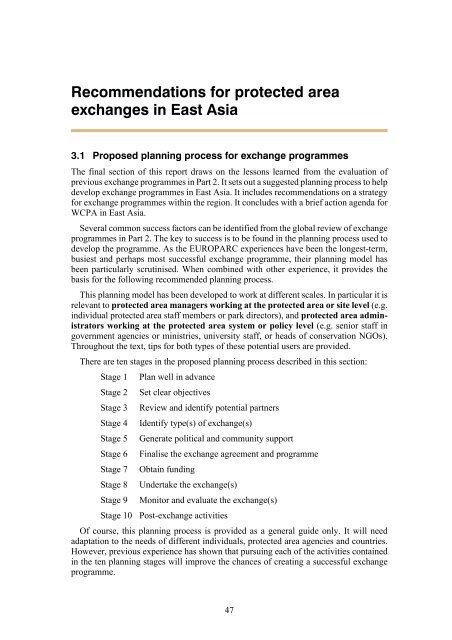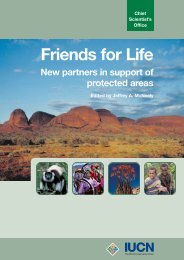Exchange programmes - IUCN
Exchange programmes - IUCN
Exchange programmes - IUCN
You also want an ePaper? Increase the reach of your titles
YUMPU automatically turns print PDFs into web optimized ePapers that Google loves.
Recommendations for protected area<br />
exchanges in East Asia<br />
3.1 Proposed planning process for exchange <strong>programmes</strong><br />
The final section of this report draws on the lessons learned from the evaluation of<br />
previous exchange <strong>programmes</strong> in Part 2. It sets out a suggested planning process to help<br />
develop exchange <strong>programmes</strong> in East Asia. It includes recommendations on a strategy<br />
for exchange <strong>programmes</strong> within the region. It concludes with a brief action agenda for<br />
WCPA in East Asia.<br />
Several common success factors can be identified from the global review of exchange<br />
<strong>programmes</strong> in Part 2. The key to success is to be found in the planning process used to<br />
develop the programme. As the EUROPARC experiences have been the longest-term,<br />
busiest and perhaps most successful exchange programme, their planning model has<br />
been particularly scrutinised. When combined with other experience, it provides the<br />
basis for the following recommended planning process.<br />
This planning model has been developed to work at different scales. In particular it is<br />
relevant to protected area managers working at the protected area or site level (e.g.<br />
individual protected area staff members or park directors), and protected area administrators<br />
working at the protected area system or policy level (e.g. senior staff in<br />
government agencies or ministries, university staff, or heads of conservation NGOs).<br />
Throughout the text, tips for both types of these potential users are provided.<br />
There are ten stages in the proposed planning process described in this section:<br />
Stage 1 Plan well in advance<br />
Stage 2 Set clear objectives<br />
Stage 3 Review and identify potential partners<br />
Stage 4 Identify type(s) of exchange(s)<br />
Stage 5 Generate political and community support<br />
Stage 6 Finalise the exchange agreement and programme<br />
Stage 7 Obtain funding<br />
Stage 8 Undertake the exchange(s)<br />
Stage 9 Monitor and evaluate the exchange(s)<br />
Stage 10 Post-exchange activities<br />
Of course, this planning process is provided as a general guide only. It will need<br />
adaptation to the needs of different individuals, protected area agencies and countries.<br />
However, previous experience has shown that pursuing each of the activities contained<br />
in the ten planning stages will improve the chances of creating a successful exchange<br />
programme.<br />
47






